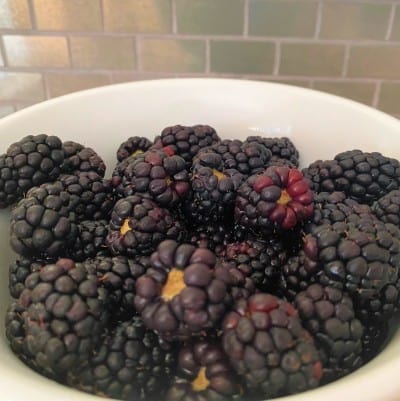When life gives you lemons, make … mousse?
You thought I was going to say lemonade! Well, refreshing beverages are not often in my thoughts, but dessert is always on my mind.
This light, cloudlike lemon mousse with Greek yogurt is a refreshing dessert, especially in warmer weather. It is a low-calorie, high-protein homemade dessert that tastes divine!

Would you like to save this recipe or article?
You won't get spam from me, I promise!
I earn from qualifying purchases at no extra cost to you as part of the Amazon Affiliate program.
Table of contents
Ingredients

- Plain unflavored Greek yogurt
- Lemon juice
- Vanilla
- Lemon zest
- Water
- Gelatin
- Egg whites
- Stevia-erythritol sweetener
- Sugar
Greek yogurt: Choose plain, unflavored whole milk for the creamiest mouthfeel. Do not use non-fat Greek yogurt!
🍋Lemon juice: Freshly squeezed will taste best in the recipe, but you can use store-bought if you're pressed for time.
Vanilla: I find that the vanilla extract from Madagascar has the best flavor. Avoid any bottles with the word "artificial" on them.
Lemon zest: You won't need more than one lemon to get enough zest for this recipe. Grate the rind finely, and avoid the bitter white pith. Here's a hand-held grater that works well for this task.
Gelatin: I have only tested this recipe with Knox gelatin. (Gelatin is rich in collagen and may do some good for your joints.)
🥚Egg whites: You could purchase whites in a carton if you don't like separating eggs. You can also use an egg separator.
Stevia-erythritol sweetener: Brands to look for are Truvia, Splenda, and Pyure. Some grocery chains have house brands, which should work fine as long as they are a granulated blend of stevia plus erythritol.
(You could also simply use more sugar. The sweetener is to help lower the total amount of sugars in the recipe.)
Sugar: Extra-fine granulated sugar melts more quickly and easily, but don't make an extra trip to the store for it. Regular granulated sugar works well, also. For best taste and texture, it's important to use some sugar.
Please don't swap in more stevia for the sugar in this recipe.
How to make it
Before starting, wash hands well, lathering with soap and rinsing with clear water.
1️⃣ In a large measuring cup or medium spouted bowl, blend the yogurt with the lemon juice, vanilla, and lemon zest. Set aside.

2️⃣ Pour the water into a small, microwave-safe bowl and sprinkle the gelatin over the top. Let it soften for a minute or two and then heat in the microwave to dissolve it.


3️⃣ Working quickly, place the egg whites plus the stevia sweetener and sugar in the top of a double boiler or heat-proof bowl set over simmering water. Heat and whisk gently to dissolve the sugar and sweetener.
The liquid should be nearly scalding.


4️⃣ Pour the warm egg whites into the bowl of a stand mixer and add the slightly cooled dissolved gelatin. Beat with a whisk attachment until the egg whites form a fluffy meringue.
(You can also use a mixing bowl and hand-held electric mixer.)

5️⃣ Fold the lemon yogurt mixture into the meringue.

6️⃣ Portion into individual serving dishes or a large serving bowl and chill.


It should be ready to serve within two hours!
Serve with a garnish of whipped cream and fresh berries.
For amounts and full recipe instructions, see below.
💖Why you'll love this mousse
You could eat two servings of this mousse and still not rack up as many calories as you might get from a lemon bar or brownie. It's perfect if you're watching your weight or have diabetes.
(Of course, there are many health benefits to this mousse. Read on!)
Unlike chocolate mousse, it sets up incredibly fast (because of the gelatin). This means that you could make it as you fix dinner and it will be ready to eat when you're finished with the dishes!
A spoonful of this mousse is like eating a cloud and nary a drop of cream necessary!
Also, you can make it with a single lemon.
Mousse is quicker than cakes and pies--you don't have to mess around with crust or with any frosting.
Mousse is more elegant than pudding. It is airier, creamier and melts on the palate.
Mousse also lends itself to a beautiful presentation. Pour it into ramekins or martini glasses. After chilling, sprinkle with cookie crumbs, toasted almond slices, whipped cream, berries, etc.
Storage and make-ahead
❄️Gelatin is sturdy stuff. It will help the mousse last 3 or more days in the refrigerator.
I love the flexibility of Lemon Mousse. You can make it the day before or merely two to three hours ahead of time. In either situation, it will still need at least a couple hours of setting time in the refrigerator.
I have never tried freezing this dessert and would not recommend it. Please let me know if you have done this. I'd love to hear what happens when you freeze it!
Is this Lemon Mousse with Greek yogurt healthy?
YES!! This may be the ultimate low-calorie, low-fat, high-protein dessert.
It clocks in at a single serving of carbohydrate if you're counting (and if you have diabetes, you probably want this information).
Between the yogurt and the egg whites, you'll get about 5.5 grams of protein, which is a meaningful amount.
Because this dessert is so low in fat, feel free to add a generous dollop of whipped cream. Here again, please don't choose non-fat or even low-fat Greek yogurt when making this recipe. The taste tradeoff is not worth it!
Many different uses
You can also use mousse to make a trifle. Just layer with cubes of angel food or pound cake along with a fruit compote or syrup. (Follow this link for a formal Lemon Mousse Trifle recipe.)
Of course, mousse also makes a delicious filling for cakes or perhaps a pie with a cookie or nut crust that does not require time in the oven.
For a lemon mousse, I recommend a gingersnap crust!
🍋🍋🍋🍋🍋🍋🍋🍋🍋🍋🍋🍋🍋🍋🍋🍋🍋🍋🍋🍋🍋🍋🍋🍋🍋🍋🍋🍋
FAQ
Absolutely! Feel free to use any sort of orange, tangerines, grapefruit, limes, etc. The results will be delightful!
This low-fat recipe does not contain a drop of cream. It is not dairy-free, however, since it has Greek yogurt in the base.
Take a look at the blog of dairy-free recipes by Chrissy Carroll if you're allergic or sensitive to cow's milk products.
Yes. The recipe below does not contain gluten. Using it to fill a pie crust or sandwiching between two cake layers could change that! 😉
They share a lemony flavor profile, but differ significantly in texture, richness, and prep.
Lemon curd, made with butter, egg yolks, and sugar, is thickened over heat. Lemon mousse is typically stabilized with gelatin and is often not cooked although the egg whites are briefly heated with the sugar in this recipe.
Also, in this Lemon Mousse, the refreshing flavor of lemon really shines because it is not blunted by heavy ingredients with high fat content like cream, egg yolks, and butter.
Also, the mousse can be a standalone dessert or a filling while lemon curd is usually a filling (lemon meringue pie) or served with scones at tea time.
Yes. It is a tried and true shortcut. Here's a recipe if you'd like to try it.
Rolled buttery wafers or thin, crispy butter cookies are a nice complement along with a generous dollop of topping (whipped cream or a plant-based version) and fresh berries.
🌿Mint leaves make a lovely garnish.
A different, also delicious, lemon mousse
Inspired by the recipe from Mark Bittman’s How to Cook Everything, I also cooked up a richer, more lemony mousse with whole eggs.
This luscious mousse is pictured below on the right. Not as airy as the mousse made with Greek yogurt (on the left), it relies on cream for richer mouthfeel.

Oh, this is where you'll find those gorgeous individual stoneware casseroles from Le Creuset. (The color is Caribbean.) They have lids and are a beautiful vessel for individual servings of anything from French onion soup to fruit crisp.
The choice of lemon mousse is based on flavor and health concerns. If you enjoy an eggy pudding, choose the creamier lemon mousse. If you're watching your waistline, make this yogurt mousse.
More recipes you might like...
Do you love the citrusy flavor of lemons? Try this Zucchini Carrot Salad with Lemony Dressing or Lemony Pasta Salad with Spinach.

Lemon Chicken Traybake is fast sheet-pan, one-dish meal that has melty slices of baked lemon infused with garlic. Yum!
You can use this zingy herbal Lemon Basil Vinaigrette on a green salad, grains, or as a sauce for chicken, fish, and shellfish. You'll love the flavor and how fast it comes together!
Want another healthy mousse dessert? Butternut Squash Mousse Parfaits are also low in calories and they are vegan. Even better, they don't need any heat to become creamy--just some time chillin' in the fridge.

Greek Yogurt Lemon Mousse
Equipment
- Bowls, various sizes
- Double boiler, can sub a heat-proof bowl set over simmering water
- Stand mixer or hand-held electric mixer
- 6 to 8 Ramekins, dessert bowls, or wine/martini glasses to use for serving
Ingredients
- 1 cup plain whole milk Greek yogurt
- 1 teaspoon lemon zest
- 3 tablespoons fresh lemon juice
- 1 teaspoon vanilla extract
- ¼ cup water
- 1 envelope about 2 ½ teaspoons unflavored gelatin
- ⅔ cup egg whites from 4 or 5 large eggs
- 1 Tablespoon of Truvia stevia+erythritol
- ½ cup sugar
Instructions
- In a small bowl, whisk together yogurt, lemon zest, lemon juice and vanilla extract. Set aside.
- In a small liquid measuring cup, add ¼ cup of water and sprinkle the gelatin over the top. Let it soften and then microwave for 30 seconds. Stir to dissolve.
- In the top of a double boiler over simmering water, whisk the egg whites, Truvia, and sugar until the sugar has dissolved and the liquid is nearly scalding. Quickly remove from heat and pour the egg-white mixture into the bowl of a stand mixer or a bowl that will accommodate an electric hand mixer. Add the dissolved gelatin.
- Beat the mixture with the whisk attachment of a stand mixer or with an electric mixer at high speed until egg whites form a fluffy meringue.
- Add lemon-yogurt mixture and fold gently until thoroughly incorporated.
- Spoon into individual serving dishes. Pour the meringue-yogurt mousse into a pastry bag or large measuring cup to make the transfer easier if you want.Refrigerate for at least an hour and a half before serving.
- When you are ready to serve, garnish with fresh berries and mint.
Notes
Nutrition
Copyright © 2024 Jani H. Leuschel







Leave a Reply